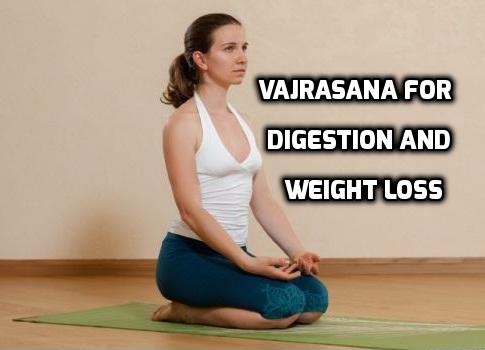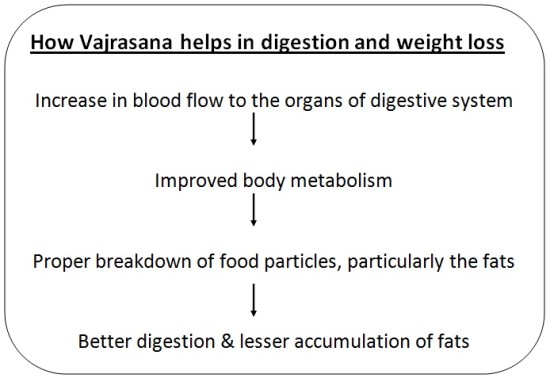
Vajrasana for Digestion and Weight Loss
Benefits of Vajrasana for digestion and weight loss are well acknowledged among yoga experts across the world. By increasing blood flow to various organs of the digestive system, vajrasana helps to eliminate various disorders like constipation, gas, bloating, acidity, heart burn and indigestion.
According to Swami Ramdev, renowned yoga guru in India, Vajrasana is an ideal yoga posture for people with poor digestion and liver related disorders.
Let us know Vajrasana
Yoga is in practice since ages for complete mind-body-spirit health and harmony. Yoga exercises give long lasting healing effect by sorting out the inner body matters.
Vajrasana a very beginner’s level yoga posture which is considered as a panacea for digestive tract related disorders.
Vajrasana= Vajra + Asana
Vajra is a Sanskrit term which means Firm or adamant.
Asana means body posture.
During Vajrasana, you have a firm, steady pose. It is also known as Adamantine pose.
Other names of Vajrasana are:
- The Diamond pose or Thunderbolt pose because diamond is a symbol of strength and toughness and Vajrasana also makes your body firm and strong.
- The Kneeling pose because it is related to knee.
How to do Vajrasana
You would need a yoga mat (blanket) and two cushions.
- Get down on your knees. Stick together both the toes.
- Now, slowly sit on your heels- rest your buttocks between the heels.
- Make sure your thighs are resting on your calves.
- Now rest your hands on the knees.
- Keep your spine and head straight.
- Close your eyes and focus on your breathing cycle- inhalation and exhalation. Breathe normally during the pose.
- If you have a flexible body, you would find sitting in vajrasana very easy. Otherwise, you would experience some pain during initial few sittings.
- If you feel pain in your ankles, toes and knees, don’t worry about it. Just undo the pose, stretch your legs and massage your ankles, knees and calf muscles gently. Then, again sit in the pose.
- If the pain is too much, you can use cushions below your toes.
- In this way, do it for at least 4 to 5 minutes. Gradually, your body would become flexible and used to it. Then, you would be able to sit in vajrasana for even up to 15 minutes without any support of cushions.
Video tutorial link (in English)- Click here
Video tutorial link (in Hindi)- Click here
Doing Vajrasana After Meals
After meals, sitting in Vajrasana for 10 to 15 minutes is considered as a great alternative to a long walk.
Vajrasana is certainly the only Yoga exercise which is allowed to perform after meals. You can do it on a full stomach to get rid of various digestive health related disorders:
- Gas and Bloating
- Constipation
- Indigestion
- Acidity and heartburn
- Bowel inflammation
Regular practice of Vajrasana after meals can help relieve hemorrhoids (piles).
Vajrasana for Digestion and Weight loss
When you sit in Vajrasana pose, blood flow towards lower part of the body (thighs and legs) gets reduced and the blood flow to the pelvic area (large intestine, small intestine and reproductive organs) increases. It results in better digestive health and improved strength of the reproductive organs. Liver functioning improves as well.
- Better digestions would result in the proper absorption of nutrients from the food that you eat to improve your overall health.
- By proper breakdown of food, it would help to burn more calories and accumulate less fats. Hence, Vajrasana aids in weight loss as well. If you are on a weight loss regimen, practicing vajrasana after every meal would greatly help you.
Vajrasana as a Preventive measure for Arthritis
Regular practice of Vajrasana makes your ankles and knee joints flexible. Hence, if you are at high risk of getting affected from arthritis- if arthritis runs in your family, then regularly practicing vajrasana can help prevent the occurrence of this disease.
Other Health Benefits of Vajrasana
- Improved sex life– As discussed above, Vajrasana increases blood flow to the reproductive organs to improve their functioning. This pose is widely recommended by yoga experts to treat erectile dysfunction and menstrual problems.
According to ancient Yoga text manuals, Vajrasana stimulates the vajra nadi which is related to genital (reproductive) organs.
- Healthy skin– Your skin is the reflection of your gut (stomach). By improving the gut health, vajrasana automatically helps you to get a healthy, glowing skin.
Read more: Anulom Vilom pranayam for Skin care
- Tone up the body muscles– Sitting in Vajrasana for longer duration tones up the body muscles of hips, thighs and calves. Reduction in belly fat is an additional benefit.
- Provides strength to body muscles– It strengthens the muscles and nerves of the lower back, hips, thighs, and calves. If you have a standing job and feel pain in feet and legs every night, sitting in vajrasana for 15 minutes after dinner would provide enough stretching and relaxation to enjoy a pain free sleep.
Vajrasana is an ideal yoga for relief from Sciatica (nerve pain affecting the back, hip and outer side of the leg).
When to do Vajrasana
Sit in vajrasana pose immediately after every meal- breakfast, lunch and dinner- for 10 to 15 minutes. If you don’t have time to sit in vajrasana after breakfast and lunch, do it after the dinner at least. You can enjoy your favorite TV program or read the newspaper while sitting in Vajrasana.
For best results, sit in vajrasana immediately after meals. A gap of more than 15 minutes after meals would not be that much effective.
Good to Know
- Various Pranayam (controlled breathing) exercises are practiced by sitting in vajrasana for enhanced health benefits. For instance, if you are dealing with chronic constipation or indigestion, doing Kapalbhati pranayam in Vajrasana pose can do wonders for you.
- A lot of people prefer to sit in vajrasana for meditation sessions for improved concentration of mind.
Safety Precautions
Vajrasana is an entry level yoga posture, quite safe to practice for people of all ages. To be on safer side, people dealing with below health issues should strictly consult a yoga expert before practicing Vajrasana.
- Any leg or knee injury
- Severe Arthritis, gout and joint pain
- Hernia, stomach ulcer and chronic diseases of small and large intestine
- Slip disc related problems
Vajrasana during Pregnancy
During the first three months, pregnant women can perform Vajrasana by keeping the knees apart so that it doesn’t put stress on the abdomen. But, yoga teacher’s guidance is suggested.
The same is applicable for women during menstrual periods- do it slowly by maintaining a slight gap between knees. If feel uncomfortable, don’t do it.
References
http://sivanandaonline.org/public_html/?cmd=displaysection§ion_id=1262
https://en.wikipedia.org/wiki/Vajrasana_(yoga)
http://www.yoga-age.com/modern/asanas.html
Image credit- http://www.ndtv.com/




